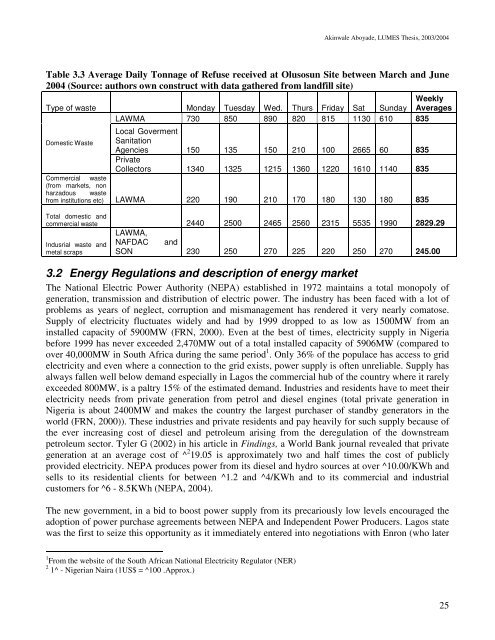Wale Aboyade's thesis - lumes
Wale Aboyade's thesis - lumes
Wale Aboyade's thesis - lumes
Create successful ePaper yourself
Turn your PDF publications into a flip-book with our unique Google optimized e-Paper software.
Akinwale Aboyade, LUMES Thesis, 2003/2004<br />
Table 3.3 Average Daily Tonnage of Refuse received at Olusosun Site between March and June<br />
2004 (Source: authors own construct with data gathered from landfill site)<br />
Type of waste Monday Tuesday Wed. Thurs Friday Sat Sunday<br />
Weekly<br />
Averages<br />
LAWMA 730 850 890 820 815 1130 610 835<br />
Local Goverment<br />
Domestic Waste Sanitation<br />
Agencies 150 135 150 210 100 2665 60 835<br />
Private<br />
Collectors 1340 1325 1215 1360 1220 1610 1140 835<br />
Commercial waste<br />
(from markets, non<br />
harzadous waste<br />
from institutions etc) LAWMA 220 190 210 170 180 130 180 835<br />
Total domestic and<br />
commercial waste 2440 2500 2465 2560 2315 5535 1990 2829.29<br />
LAWMA,<br />
Indusrial waste and NAFDAC and<br />
metal scraps SON 230 250 270 225 220 250 270 245.00<br />
3.2 Energy Regulations and description of energy market<br />
The National Electric Power Authority (NEPA) established in 1972 maintains a total monopoly of<br />
generation, transmission and distribution of electric power. The industry has been faced with a lot of<br />
problems as years of neglect, corruption and mismanagement has rendered it very nearly comatose.<br />
Supply of electricity fluctuates widely and had by 1999 dropped to as low as 1500MW from an<br />
installed capacity of 5900MW (FRN, 2000). Even at the best of times, electricity supply in Nigeria<br />
before 1999 has never exceeded 2,470MW out of a total installed capacity of 5906MW (compared to<br />
over 40,000MW in South Africa during the same period 1 . Only 36% of the populace has access to grid<br />
electricity and even where a connection to the grid exists, power supply is often unreliable. Supply has<br />
always fallen well below demand especially in Lagos the commercial hub of the country where it rarely<br />
exceeded 800MW, is a paltry 15% of the estimated demand. Industries and residents have to meet their<br />
electricity needs from private generation from petrol and diesel engines (total private generation in<br />
Nigeria is about 2400MW and makes the country the largest purchaser of standby generators in the<br />
world (FRN, 2000)). These industries and private residents and pay heavily for such supply because of<br />
the ever increasing cost of diesel and petroleum arising from the deregulation of the downstream<br />
petroleum sector. Tyler G (2002) in his article in Findings, a World Bank journal revealed that private<br />
generation at an average cost of ^219.05<br />
is approximately two and half times the cost of publicly<br />
provided electricity. NEPA produces power from its diesel and hydro sources at over ^10.00/KWh and<br />
sells to its residential clients for between ^1.2 and ^4/KWh and to its commercial and industrial<br />
customers for ^6 - 8.5KWh (NEPA, 2004).<br />
The new government, in a bid to boost power supply from its precariously low levels encouraged the<br />
adoption of power purchase agreements between NEPA and Independent Power Producers. Lagos state<br />
was the first to seize this opportunity as it immediately entered into negotiations with Enron (who later<br />
1 From the website of the South African National Electricity Regulator (NER)<br />
2 1^ - Nigerian Naira (1US$ = ^100 .Approx.)<br />
25

















